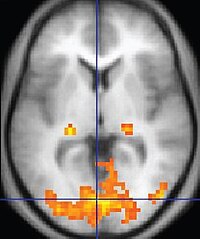
Photo from wikipedia
Resting‐state functional magnetic resonance imaging (fMRI) has been used in numerous studies to map networks in the brain that employ spatially disparate regions. However, attempts to map networks with high… Click to show full abstract
Resting‐state functional magnetic resonance imaging (fMRI) has been used in numerous studies to map networks in the brain that employ spatially disparate regions. However, attempts to map networks with high spatial resolution have been hampered by conflicting technical demands and associated problems. Results from recent fMRI studies have shown that spatial resolution remains around 0.7 × 0.7 × 0.7 mm3, with only partial brain coverage. Therefore, this work aims to present a novel fMRI technique that was developed based on echo‐planar‐imaging with keyhole (EPIK) combined with repetition‐time‐external (TR‐external) EPI phase correction. Each technique has been previously shown to be effective in enhancing the spatial resolution of fMRI, and in this work, the combination of the two techniques into TR‐external EPIK provided a nominal spatial resolution of 0.51 × 0.51 × 1.00 mm3 (0.26 mm3 voxel) with whole‐cerebrum coverage. Here, the feasibility of using half‐millimetre in‐plane TR‐external EPIK for resting‐state fMRI was validated using 13 healthy subjects and the corresponding reproducible mapping of resting‐state networks was demonstrated. Furthermore, TR‐external EPIK enabled the identification of various resting‐state networks distributed throughout the brain from a single fMRI session, with mapping fidelity onto the grey matter at 7T. The high‐resolution functional image further revealed mesoscale anatomical structures, such as small cerebral vessels and the internal granular layer of the cortex within the postcentral gyrus.
Journal Title: Human Brain Mapping
Year Published: 2022
Link to full text (if available)
Share on Social Media: Sign Up to like & get
recommendations!